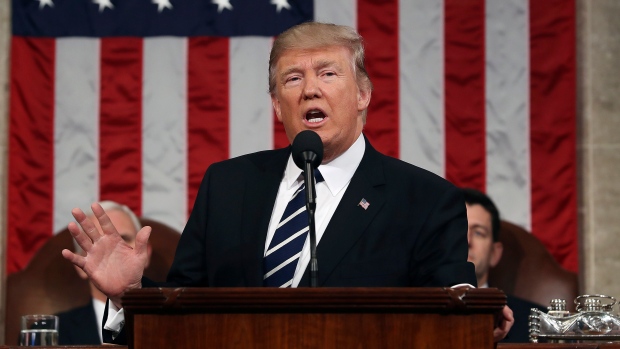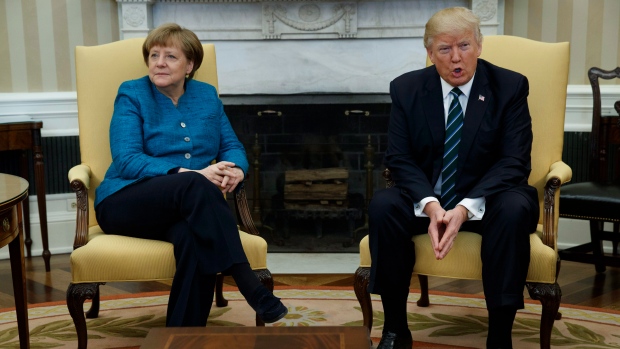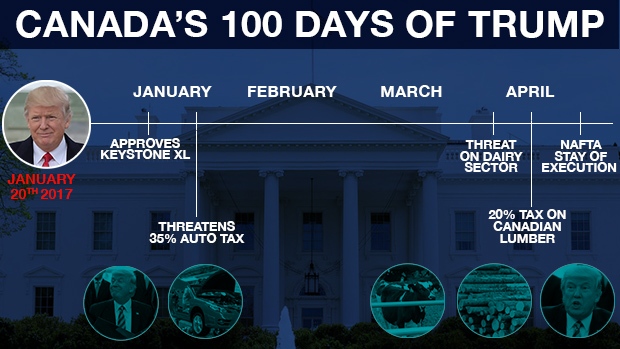Apr 28, 2017
100 days: A President Trump timeline

Friday, January 20, 2017
Donald Trump is sworn in as the 45th president of the United States. In his inaugural address, Trump pledges to put America first during his presidency. "Every decision on trade, on taxes, on immigration, on foreign affairs will be made to benefit American workers and American families," he said.
Foreign Affairs Minister Chrystia Freeland, Defence Minister Harjit Sajjan, Natural Resources Minister Jim Carr and Parliamentary Secretary Andrew Leslie attend the inauguration. Trump and White House Spokesman Sean Spicer wrongly claim the inauguration ceremony drew the "largest audience" ever.
The next day more than four million people around the world attend the women’s march protesting the Trump administration. It is the largest single-day protest in U.S. history.
Monday, January 23, 2017
President Trump signs a memorandum withdrawing the U.S. from the proposed Trans-Pacific Partnership.
Tuesday, January 24, 2017
Trump signs a memorandum reversing Barack Obama’s decision to block the Keystone XL and Dakota Access oil pipelines. Trump also signs a memorandum requiring pipelines to use domestic steel in any new pipelines. The White House later exempts TransCanada from this requirement.
Wednesday, January 25, 2017
Trump signs an executive order directing the Department of Homeland Security to begin construction of a wall along the U.S.-Mexico border. Mexican President Enrique Peña Nieto rejects the idea that Mexico will pay for the wall and later cancels a planned meeting with Trump.
The next day Spicer says the wall could be paid for with a 20 per cent Mexico border tax. He later retracts the statement.
Trump also announces his intention to investigate voter fraud in the 2016 presidential election based on his unsubstantiated claims that millions of people illegally voted for his defeated rival Hillary Clinton.
Friday, January 27, 2017
British Prime Minister Theresa May is the first foreign leader to visit the White House since the inauguration.
Trump signs an executive order suspending refugee admissions for 120 days and denying entry to citizens from the Muslim-majority countries of Iraq, Iran, Libya, Somalia, Sudan, Syria and Yemen for 90 days.
The so-called ban causes chaos at U.S. airports and widespread condemnation and protests. Tech executives in Canada call on Ottawa to provide temporary refugee status to affected workers. Two days later courts in several U.S. states issue orders halting implementation of the executive action.
Tuesday, January 31, 2017
Trump nominates Neil Gorsuch to the U.S. Supreme Court to fill the vacancy left by Antonin Scalia, who died in February 2016.
Monday, February 13, 2017
Trump holds a bilateral meeting and joint press conference with Prime Minister Justin Trudeau at the White House.
Trump National Security Advisor Michael Flynn resigns following allegations he failed to disclose meetings with Russia to discuss the potential removal of U.S. sanctions. The move comes amid continued media coverage of alleged improper contact with Russia during the presidential election.
Tuesday, February 28, 2017
Trump makes his first speech to a joint session of the U.S. Congress. Pundits praise the “presidential” tone of the speech that addresses matters including immigration, gang crime, trade and infrastructure.
Wednesday, March 1, 2017
The U.S. Congressional House Intelligence Committee opens an inquiry into allegations of Russian interference in the 2016 elections.
U.S. Attorney General Jeff Sessions says he met with Russians during the election and later promises to recuse himself from any Russia–linked investigations.
Dow soars 200 points to top 21,000 for the first time following Trump’s speech.
Saturday, March 4, 2017
In a series of early morning tweets, Trump accuses former President Obama of “wiretapping” Trump’s offices at Trump Tower during the election campaign. Trump provides no evidence and an Obama spokesman denies the claim. In the coming weeks, current and former intelligence and U.S. justice officials say there is no evidence to support the president’s claim.
Thursday, March 6, 2017
Trump releases a preliminary draft of a 2018 budget calling for a US$54-billion increase in defense spending and deep cuts to foreign aid and the State and Environment Protection Agency.
Trump issues a second “travel ban.” The order removes Iraq from the list of Muslim-majority countries whose citizens were blocked. Several U.S. states file court challenges which ultimately strike down Trump’s order for a second time.
Friday, March 17, 2017
Trump holds a bilateral meeting and joint press conference with German Chancellor Angela Merkel. The meeting between the two leaders is noticeably awkward and Trump appears to ignore requests from both the media and Merkel to shake hands.

Monday, March 20, 2017
Trump issues a tweet rejecting allegations of collusion with Russia as "fake news”.
Friday, March 24, 2017
A Republican bill to repeal and replace the Affordable Care Act, better known as “Obamacare”, is withdrawn indefinitely after U.S. House Speaker Paul Ryan admits the bill lacks the votes to pass. It is a major defeat for a promise Republicans have been campaigning on since Obama’s bill was passed in 2010.
Trump issues a presidential permit to allow construction of the Keystone XL pipeline by TransCanada Corp. TransCanada CEO Russ Girling stands next to Trump during the Oval Office ceremony. When Trump asks when construction would start, Girling replies, "We've got some work to do in Nebraska to get our permits there.”
"Nebraska?" Trump said. "I'll call Nebraska."
Tuesday, March 28, 2017
Trump signs an executive order removing the directive to consider climate change during EPA deliberations. The order also removes restrictions on fracking and directs the EPA to suspend, revise or abolish Obama’s Clean Power Plan.
Thursday, March 30, 2017
The Trump administration delivers to the U.S. Congress a draft list of priorities for potential renegotiation of the North American Trade Agreement. It is the first step in opening up NAFTA.
Friday, March 31, 2017
Trump signs two executive orders aimed at preventing foreign trade abuses. The signing occurred behind closed doors after Trump walked out of a public signing without having signed the orders.
Tuesday, April 4, 2017
A Sarin gas attack in a rebel-held area of Syria kills at least 70 civilians, including children. After video footage of the casualties is broadcast, Trump calls the attack "reprehensible" and criticizes the Obama administration for not doing more to regulate chemical weapons.
Thursday, April 6, 2017
Chinese President Xi Jinping arrives in Florida for two days of meetings with Trump at the Mar-a-Lago mansion.
Trump orders the firing of 59 cruise missiles at a military airbase in Syria as retaliation for the use of chemical weapons. The action is contrary to numerous tweets Trump issued over the years arguing the U.S. should not use military force in Syria.
Friday, April 7, 2017
The U.S. senate confirms Trump Supreme Court Nominee Justice Neil Gorsuch in a vote of 54–45.
Wednesday, April 12, 2017
Trump announces three major reversals in his economic policies. He says he will not label China a currency manipulator. He also indicates that he no longer wants to eliminate the Import-Export Bank – a government body similar to Canada’s Export Development Bank. And he says he could consider reappointing Janet Yellen as chair of the Federal Reserve.
Tuesday, April 18, 2017
In a speech in Wisconsin to promote his signing of a “Buy American, Hire American” executive order, Trump takes direct aim at Canadian dairy farmers. Trump says "unfair things have happened" to U.S. dairy farmers. While Canada’s dairy supply management system is not covered under the NAFTA, Trump reiterates his pledge to renegotiate the trade deal.
Thursday, April 20, 2017
Trump doubles down on his attacks on Canada’s dairy sector and adds Canadian “lumber, timber and energy” to the list of trade irritants. Trump also steps up his attacks on NAFTA. "The fact is NAFTA, whether it's Mexico or Canada, is a disaster for our country. It's a disaster. It's a trading disaster.”
Monday April 24, 2017
Trump follows through on this tough trade talk and imposes a 20 per cent tariff on Canadian softwood lumber imports.
Tuesday, April 25, 2017
The Trump administration continues to attack Canada on the trade front. U.S. Commerce Secretary Wilbur Ross tells reporters at the White House: “(Canada is) a close ally, they are an important ally, they are generally a good neighbour — that doesn’t mean they don’t have to play by the rules.”
Later, at a signing ceremony, Trump tells reporters he has “no fear” of a potential trade war with Canada. "People don't realize Canada's been very rough on the United States," Trump said at a signing ceremony. "Everyone thinks of Canada as being wonderful, and so do I. I love Canada. But they've outsmarted our politicians for many years."
Wednesday, April 25, 2017
The Trump administration unveils a broad plan of tax cuts and tax reform that would drop the U.S. corporate tax rate to 15 per cent and simplify the tax code.
Both the Canadian dollar and Mexican Peso react amid reports that Trump is considering a plan to pull out of NAFTA. After phone calls with both Canada and Mexico, Trump backs down from the threat, for now.
